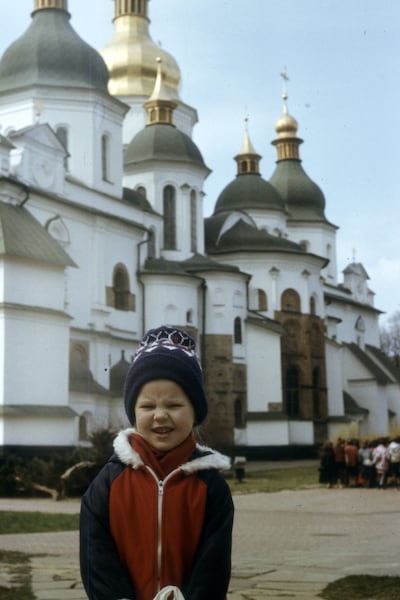This article was first published in the State of Faith newsletter. Sign up to receive the newsletter in your inbox each Monday night.
When I was growing up in the Soviet Union, religion was viewed with deep suspicion. Public expressions of faith were discouraged and proselytizing was against the law. According to the state’s communist doctrine, God did not exist.

I was 6 years old when the Soviet Union collapsed and Ukraine stepped into a new era of democracy, free speech and expanded religious freedom. I remember those early days of openness. In the heart of Kyiv, where I lived, different religious groups would gather in the city center. They passed out flyers, preached through megaphones and invited strangers to come and learn. You could now talk — and even yell — about God. There was energy in the air. A spiritual hunger could finally be filled.
One of those seekers was my father, a logical, scientifically minded man, who had long wrestled with big questions and found them answered by two young Latter-day Saint missionaries. In 1991, he became one of the first Ukrainians to join The Church of Jesus Christ of Latter-day Saints. I tagged along with him to worship services, then held in a building once used for Soviet labor union meetings.
These early experiences shaped my view of religion. I learned early that the freedom to worship in public, to speak about your faith, to search for meaning in community was not something to take for granted. In the past decade of reporting on faith and culture, I saw how faith shapes what we value and how we pray, but also how we vote, lead, serve and gather.
That brings me to why I believe this newsletter matters. For about a decade, Kelsey Dallas has been a thoughtful and trusted voice helping Deseret readers understand the evolving role of faith in public life. She brought clarity and heart to complex religious questions, especially when it comes to analysis of faith-related Supreme Court cases.
I’m honored to carry this work forward and bring something new to the conversation. I hope you’ll continue with me on this journey.
I believe it’s an incredibly exciting time for faith in America. The decades-long rise of the religiously unaffiliated has stalled, according to the Pew Research Center. The gender gap in religious participation is narrowing. Some young people are finding their way back to church in search of meaning and community. Religious freedom remains a contested issue and is currently at the heart of several high-profile cases before the Supreme Court.
Eighty-six percent of Americans believe that a soul or spirit inhabits a physical body, according to Pew. “I was trying to think of anything else that 86% of Americans agree on, and I couldn’t come up with anything,” said Penny Edgell, University of Minnesota professor, who worked on Pew’s report. “That’s remarkably high.”
In the weeks ahead, I’ll be looking into the religious liberty debate surrounding Washington state’s new law requiring Catholic priests to break confession seal to report child abuse. The U.S. Department of Justice filed a lawsuit challenging it, and I’ll be watching closely how it unfolds. I’ll also be reporting on how different communities are finding surprising ways to bridge religious divides and work together. I’ll explore the many ways religion intersects with politics, education, science, and family.
I hope you’ll join me in this next chapter of State of Faith.
Fresh off the press
Despite a decline in churchgoing, more young adults are reaching for the Bible
Meet the Utah mom using TikTok to stop bullies in their tracks
The Deseret News recently celebrated its 175th birthday. My colleague Tad Walch took a look at how the Deseret News has covered faith and religion throughout its 175 years.
Term of the week: Castel Gandolfo
Even popes need a summer vacation.
Pope Leo XIV will retreat to the Papal Palace in Castel Gandolfo for a summer getaway next month, a papal tradition that stopped with Pope Francis.
“Pope Francis, who died just after Easter, was known as a workaholic homebody who never took a proper vacation during his 12-year papacy, staying at the Vatican even during the hot summer months,” according to The Associated Press.
From July 6-20, Pope Leo will stay in the palace, located roughly an hour south of the Vatican.
The Papal Palace was constructed in 1624 by Pope Urban VIII to serve as “an escape from the sweltering Roman summer,” per AP. He will also return to Castel Gandolfo for a few days in August during the Catholic Assumption feast day.
While in Castel Gandolfo, Pope Leo will offer the Angelus blessing on July 13, July 20, Aug. 15 and Aug. 17.
What I’m reading
I’ve been moved by Pope Leo’s powerful plea for peace after the U.S. bombing of Iran’s nuclear sites. His words struck a personal chord. “War does not solve problems, but rather it amplifies them and produces deep wounds in the history of people that take generations to heal,” he said, according to the National Catholic Reporter. “No armed victory can compensate for the pain of mothers, the fear of children, the stolen future.”
Some families in Maine have installed a landline and formed a “landline pod” to avoid getting smartphones for their kids. It’s proven to be a creative alternative so far.
My colleague Gitanjali Poonia traveled to Los Angeles to report on the devastating impact that the fires had on the houses of worship.
This essay by Ian Marcus Corbin is a multifaceted exploration on nature and beauty. He asks: “Why do we shy from paying attention to nature’s beauty?”
Odds and ends
I would love to hear from you. What are the questions or stories I should be exploring for this newsletter? Send me a note anytime at mmanzhos@deseretnews.com.
Thanks for reading. I’m so excited for what’s ahead.


